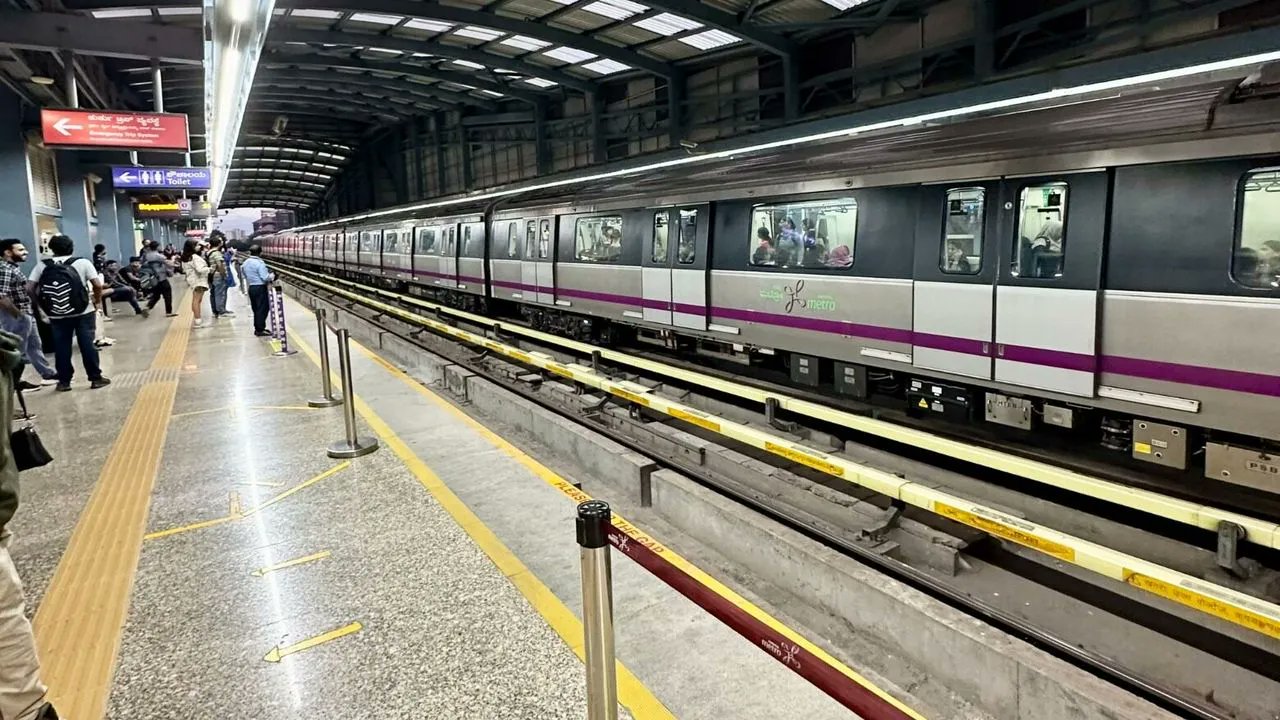Revised fares are approved by the BMRCL Board as per the Fare Fixation Committee’s recommendations, with a continued 5 percent discount on Smart Cards.
Published Feb 08, 2025 | 6:31 PM ⚊ Updated Feb 08, 2025 | 6:36 PM

Bengaluru Metro.
Synopsis: Bengaluru’s Namma Metro fare hike, effective from 9 February 2025, introduces revised rates based on distance. Fares for journeys up to 2 km will remain at ₹10, while the maximum fare for journeys over 30 km will be capped at ₹90. The revised rates will be applicable across all ten fare zones. In addition to the fare revisions, BMRCL has decided to retain the 5 percent discount on Smart Cards, which will also be extended during off-peak hours.
Bengaluru’s Namma Metro commuters will soon have to pay more for their journeys. A fare hike announced by the Bengaluru Metro Rail Corporation Limited (BMRCL) is set to come into effect on 9 February.
The revised fares, approved by the BMRCL Board, are based on the recommendations of the Fare Fixation Committee (FFC) constituted under the Metro Railway Operations and Maintenance Act, 2002.
The new fare structure aims to strike a balance between affordability and financial sustainability for the city’s rapidly expanding metro network.
#Bengaluru: #NammaMetro fare hike to take effect from 9 Feb 2025 as per the Fare Fixation Committee’s recommendations.
A 5% discount on Smart Cards will continue. The revised fares were approved by the BMRCL Board as per the Metro Railway O&M Act. pic.twitter.com/fZDIOoLJH0
— South First (@TheSouthfirst) February 8, 2025
Also Read: Public transport fare hike in Bengaluru sparks concern amid rising costs
Fares for journeys up to 2 km will remain at ₹10, while the maximum fare for journeys over 30 km will be capped at ₹90. The revised rates will be applicable across all ten fare zones.
Here are the revised rates:
In addition to the fare revisions, BMRCL has decided to retain the 5 percent discount on Smart Cards, which will also be extended during off-peak hours.
Commuters using Smart Cards during these hours—defined as opening to 8 am, 12 pm to 4 pm, and 9 pm to closing—will receive an additional 5 percent discount, effectively reducing their travel costs by 10 percent.
On Sundays and select national holidays, Smart Card users will continue to enjoy a flat 10 percent discount throughout the day.
The decision to increase fares has also reignited a debate about metro affordability. Bengaluru Central MP PC Mohan had previously claimed that central government directives delayed the hike, terming it a victory for the city’s residents.
BMRCL’s proposed 45% metro fare hike, set for Feb 1, has been put on hold. The Modi government has directed BMRCL to submit a comprehensive report before making any decision. A big win for the people of Bengaluru—ensuring transparency, accountability, and fair metro pricing. pic.twitter.com/5LBJT70mX2
— P C Mohan (@PCMohanMP) January 29, 2025
However, BMRCL clarified that the timeline aligns with the FFC’s binding recommendations and was necessary to ensure the metro’s financial viability.
For tourists and group travellers too, the revised fares bring significant changes. A one-day tourist pass will now cost ₹300, while three-day and five-day passes are priced at ₹600 and ₹800, respectively.
Discounts of up to 25 percent will apply to group tickets, depending on the group size and travel conditions.
The revision comes as part of BMRCL’s efforts to address rising operational costs and expanded infrastructure, with the last fare increase implemented years ago.
According to BMRCL, the hike ensures better financial sustainability while keeping fares accessible for short-distance commuters.
BMRCL’s Chief Public Relations Officer speaking to South First stated that the fare hike was essential to offset rising operational costs and the financial demands of extending the metro network.
“We have ensured that frequent travellers, especially Smart Card users, continue to benefit through discounts. These measures will also encourage off-peak travel, reducing congestion during busy hours,” the official said.
Despite the assurances, questions remain about the impact on daily commuters. Advocacy groups and civic organisations have called for measures to further ease the burden on those most affected by the hike, including introducing more affordable season passes for students and low-income workers.
As the fare revision takes effect, Bengaluru’s metro riders are left weighing the increased costs against the undeniable convenience of avoiding the city’s notorious traffic.
Whether the changes will result in higher ridership or push some back to road-based alternatives remains to be seen.
(Edited by Sumavarsha)
